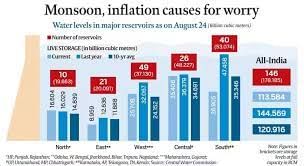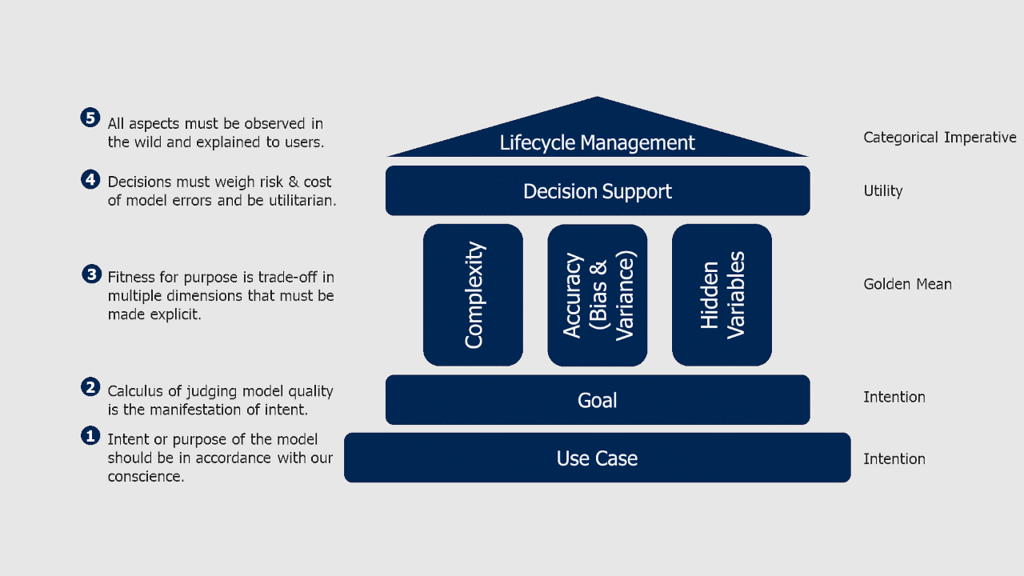UPSC Daily Current Affairs- 28th August 2023 | Current Affairs & Hindu Analysis: Daily, Weekly & Monthly PDF Download
GS-I
Why El Nino is now India’s no. 1 Economic and Political Risk?
Subject: Geography

Why in News?
The emergence of El Nino as a significant climatic phenomenon in India carries dual implications – economic and political – as the country gears up for national elections in April-May 2024.
- With its known ability to suppress rainfall and disrupt agricultural cycles, El Nino’s effects are already being felt.
Understanding El Nino and La Nina
- El Nino and La Nina are two opposite phases of the El Nino-Southern Oscillation (ENSO) cycle.
- ENSO is a naturally occurring phenomenon that involves the interaction between the ocean and atmosphere in the equatorial Pacific.
Here is a detailed comparison of El Nino and La Nina
| El Nino | La Nina | |
| Definition | Warmer-than-normal sea surface temperatures | Cooler-than-normal sea surface temperatures |
| Frequency | Every two to seven years | Every two to seven years |
| Duration | Several months to a year or more | Several months to a year or more |
| Impact on winds | Weakens trade winds, leading to changes in patterns | Strengthens trade winds, leading to changes in patterns |
| Impact on rains | Reduces rainfall and can cause droughts | Increases rainfall and can cause flooding |
| Impact on temp. | Warmer-than-average temperatures | Colder-than-average temperatures |
| Global effects | Droughts in Asia and Africa, floods in Americas | Floods in Asia and Africa, droughts in South America |
Impact on India
| El Nino | La Nina |
| Associated with weak monsoons and drought-like conditions in India | Associated with above-normal rainfall and floods in India |
| Sea surface temperature in the equatorial Pacific Ocean rises above normal levels | Sea surface temperature in the equatorial Pacific Ocean drops below normal levels |
| Changes in the atmospheric circulation patterns | Changes in the atmospheric circulation patterns |
| Shift in the location of the jet stream, affecting the strength and direction of the monsoon winds | Increase in the strength of the monsoon winds, bringing more moisture and rainfall to India |
| Results in reduced rainfall, dry spells, and heatwaves, leading to crop failures and water scarcity | Excessive rainfall can also lead to floods and landslides, causing damage to crops and infrastructure |
Broader Implications:
[A] Agriculture
- Rainfall Deficit: August’s nationwide rainfall stands at 30.7% below normal, erasing the initial 4.2% surplus from the southwest monsoon.
- Strengthening El Nino: July saw the Oceanic Nino Index (ONI) surpass the El Nino threshold, hitting 1 degree Celsius, suggesting an intensification of El Nino.
- Projected Persistence: Forecasts predict El Nino’s continuation and possible strengthening during the 2023-24 winter season, potentially impacting the northeast monsoon and winter seasons.
[B] Food Supply Challenges
- Crucial Monsoon: Beyond crop yield, the southwest monsoon replenishes reservoirs and recharges groundwater, essential for agricultural success.
- Rabi Season Dependence: The success of rabi season crops like wheat, mustard, and chickpea hinges on water reserves, primarily sourced from aquifers and reservoirs.
- Supply-Demand Nexus: With rice and wheat stocks at a six-year low and food inflation at 11.5%, El Nino-induced shortfalls may exacerbate food inflation concerns.
[C] Political Implications
- Food Inflation: Examining consumer food price inflation leading up to previous Lok Sabha elections reveals its considerable impact on political outcomes.
- Electoral Influence: The BJP’s 2019 electoral victory and the UPA’s 2014 defeat were partially attributed to the level of food inflation during those periods.
- Government Actions: The Modi administration has already taken steps to ensure food availability, curb hoarding, and address potential food inflation concerns.
Navigating the Priorities
- Anticipated Measures: As El Nino’s effects continue and the 2024 Lok Sabha elections approach, the Modi government may adopt further measures to stabilize food supply.
- Balancing Act: While these measures aim to mitigate short-term food inflation, they could potentially clash with previously enacted farm reform laws, highlighting the tension between immediate policy actions and long-term structural changes.
Conclusion
- El Nino’s emergence as a formidable environmental and political factor underscores the intricate interplay between climate patterns, agriculture, and political dynamics.
- India’s ability to manage the far-reaching consequences of El Nino on food production and inflation will determine its capacity to address immediate challenges while considering the longer-term goals.
Source: The Indian Express
GS-II
Zonal Councils
Subject: Polity

Why in News?
Union Home Minister will chair the 26th meeting of the Western Zonal Council at Gandhinagar.
About Zonal Councils:
- The idea of the creation of Zonal Councils was mooted by the first Prime Minister of India, Pandit Jawahar Lal Nehru, in 1956.
- In the light of the vision of Pandit Nehru, five Zonal Councils were set up vide Part-III of the States Re-organisation Act, 1956. Hence, they are statutory bodies.
- The act divided the country into five zones (Northern, Central, Eastern, Western and Southern) and provided a zonal council for each zone.
- The Zonal Councils provide an excellent forum where irritants between the Centre and States and amongst States can be resolved through free and frank discussions and consultations.
- The main objectives of setting up Zonal Councils are to-
- Bring out national integration;
- Arrest the growth of acute State consciousness, regionalism, linguism and particularistic tendencies;
- Enable the Centre and the States to cooperate and exchange ideas and experiences;
- Establish a climate of cooperation amongst the States for successful and speedy execution of development projects.
- Each Zonal Council is an advisory body and may discuss any matter in which some or all of the States represented in that Council, or the Union and one or more of the States represented in that Council, have a common interest and advise the Central Government and the Government of each State concerned as to the action to be taken on any such matter.
- In particular, a Zonal Council may discuss and make recommendations with regard to:
- any matter of common interest in the field of economic and social planning;
- any matter concerning border disputes, linguistic minorities or inter-state transport;
- any matter connected with or arising out of the reorganisation of the States under the States Reorganization Act;
- Organisational Structure:
- Chairman: The Union Home Minister is the Chairman of each of these Councils.
- Vice Chairman: The Chief Ministers of the States included in each zone act as Vice-Chairman of the Zonal Council for that zone by rotation, each holding office for a period of one year at a time.
- Members: Chief Minister and two other Ministers as nominated by the Governor from each of the States and two members from Union Territories included in the zone.
- Advisers: One person nominated by the Planning Commission for each of the Zonal Councils, Chief Secretaries and another officer/Development Commissioner nominated by each of the States included in the Zone.
- The Chief Secretaries of the States represented in such Zonal Councils act as the Secretary of the respective Council by rotation, holding office for a period of one year at a time.
- The Joint Secretary of Zonal Councils is a Director Level officer from All India Services or Central Secretariat Services.
- North Eastern Council:
- The North Eastern States,e. (i) Assam, (ii) Arunachal Pradesh, (iii) Manipur, (iv) Tripura, (v) Mizoram, (vi) Meghalaya, and (vii) Nagaland, are not included in the Zonal Councils and their special problems are looked after by the North Eastern Council, set up under the North Eastern Council Act, 1972.
- The North Eastern Council (Amendment) Act of 2002 also added the state of Sikkim to the North Eastern Council.
Source: The Hindu
Global Framework on Expansion of Ethical AI Tools
Subject: Polity and Governance

Why in News?
With the G20 Summit on the corner, the Indian PM’s call for a global framework on expansion of “ethical” artificial intelligence (AI) tools aims at taking a leadership position on the need for regulating sectors such as AI and cryptocurrencies.
- The PM was speaking at the Business 20 (B20) Summit organised by the Confederation of Indian Industries (CII), ahead of the G20 Summit next month.
Responsible AI for All:
- In 2018, NITI Aayog released the National Strategy on Artificial Intelligence (NSAI), highlighting the roadmap to adopt AI in five public sectors in a manner that is safe and dispenses benefits to all citizens.
- The strategy document coined the “AI for All” mantra, to be the governing benchmark for future AI design, development, and deployment in India.
- A part of this strategy was to ensure the safe and responsible use of AI.
- As a follow-up to NSAI, the NITI Aayog identified principles (RAI principles) for responsible design, development, and deployment of AI in India, and set out enforcement mechanisms to operationalise these principles.
- As the next step 7 principles were formulated:
- Safety and reliability,
- Inclusivity and non-discrimination,
- Equality, privacy and security,
- Transparency,
- Accountability,
- Protection and
- Reinforcement of positive human values were identified to determine the efficacy of the approach recommended and identify challenges.
Governing AI - A Blueprint for India:
- India is experiencing a significant technological transformation that presents a tremendous opportunity to leverage innovation for economic growth.
- Policymakers across jurisdictions have stepped up regulatory scrutiny of generative AI tools, prompted by Chat GPT’s explosive launch.
- The concerns being flagged fall into three broad heads: privacy, system bias and violation of intellectual property rights.
- In this backdrop, Tech major Microsoft (which has a stake in OpenAI) had recently floated a blueprint for AI governance in India titled “Governing AI: A Blueprint for India”.
- This paper offers some of our ideas and suggestions as a company, placed in the Indian context.
- The paper proposed regulations prescribing safety and security requirements, with post-deployment safety and security monitoring and protection.
- Microsoft has offered to share its “specialised knowledge” about advanced AI models to help the government define the regulatory threshold.
Shift in India’s own Position on Regulating AI:
- Recently, the Ministry of Electronics and IT (MietY) had said that it is not considering any law to regulate the AI sector.
- The MeitY admitted that though AI had ethical concerns and associated risks, it had proven to be an enabler of the digital and innovation ecosystem.
- The PM’s address at the B20 shows a shift in New Delhi’s own position - from not considering any legal intervention on regulating AI in the country to moving in the direction of formulating regulations based on a “risk-based, user-harm” approach.
- Part of this shift was reflected in a TRAI’s consultation paper, which said that the Centre should set up a domestic statutory authority to regulate AI in India through the lens of a “risk-based framework”.
- TRAI also called for collaborations with international agencies and governments of other countries for forming a global agency (with regulatory oversight) for the “responsible/ ethical use” of AI.
- The TRAI’s recommendation is broadly in line with an approach enunciated by Sam Altman, the founder of OpenAI (the company behind ChatGPT).
- He had called for an international regulatory body for AI, akin to that overseeing nuclear non-proliferation.
- This also comes amid indications that Centre is looking to introduce the Digital India Bill that is expected to replace the Information Technology (IT) Act, 2000.
- The Bill draws a clear distinction between different types of online intermediaries, including AI-based platforms, and issues specific regulations for each of these intermediaries.
Highlights of the PM Address at the B20:
- The PM called for a global framework to ensure the ethical use of AI as he flagged challenges of skilling and reskilling, and algorithmic bias and its impact on society.
- Global business communities and governments have to ensure the expansion of ethical AI across different sectors.
- Emphasising the need to deepen mutual trust and cooperation between countries, he called for a similar, integrated approach to deal with issues related to cryptocurrencies.
- He cited the examples of the aviation and financial sectors which have seen global coordination.
- Cautioning against a “self-centric” approach, he said that if businesses and governments don’t shoulder global responsibility, it could result in a “new colonial model”.
Source: Indian Express
Patient Safety and Neonatal Care: India’s Efforts and Challenges
Subject: Governance

Why in News?
The recent conviction of a former British nurse highlights the importance of patient safety in healthcare systems.
- While neonatal safety is not governed by exclusive rules, there are provisions to ensure the wellbeing of newborns and minimize potential risks.
Patient Safety Provisions in India
- Defining Patient Safety: Patient safety is defined as freedom from harm or potential harm associated with healthcare provision, according to the ‘National Patient Safety Implementation Framework (2018-2025).’
- Legal Protection: Patients in India are protected under various laws, including the Consumer Protection Act, Clinical Establishment Act, and mechanisms by the National Pharmaceutical Pricing Authority and Drugs Controller General of India to safeguard patients’ rights.
- Fragmented Laws: Patient safety is governed by a range of laws, from the Hippocratic Oath to clinical establishment regulations, reflecting a multifaceted approach to ensure safe healthcare practices.
Neonatal Safety and Care
- Proactive Measures: While no exclusive rules exist for neonatal care, provisions against issues like mix-ups and abductions are present. Deliberate harm is extremely rare and often linked to complex psychiatric illnesses.
- Comprehensive Provisions: Neonatal safety is ensured through comprehensive provisions that include staffing, equipment, infection control, parental involvement, training, and continuing medical education.
- Human Errors: In a country with a high birth rate, human errors may occur in neonatal care, but planned, deliberate harm remains an exceptional occurrence.
Neonatal Health Challenges
- Global Neonatal Deaths: Despite a decline in global neonatal deaths, newborns face the highest risk of death within the first 28 days of life. A significant proportion of under-five deaths occur during the newborn period.
- India’s Scenario: India’s infant mortality rate is gradually declining, but pre-term birth, complications during birth, infections, and birth defects remain major causes of neonatal deaths.
- Improving Neonatal Survival: Ensuring proper neonatal care and addressing the key challenges can contribute to reducing neonatal mortality rates and improving child health outcomes.
Promoting Neonatal Safety
- Midwife-Led Continuity of Care: Professional midwives providing midwife-led continuity of care (MLCC) significantly reduce the risk of neonatal and pre-term birth. This approach emphasizes the importance of skilled care during childbirth and the immediate postnatal period.
- Seeking Prompt Medical Care: Families are advised to seek prompt medical care in case of danger signs in newborns and to follow vaccination schedules for timely protection. This proactive approach helps prevent and manage potential health risks in neonates.
- Ensuring Proper Training: Proper training of healthcare providers, especially those in neonatal services, is crucial for maintaining high-quality care and adherence to safety standards.
Conclusion
- Patient safety and neonatal care form the foundation of a robust healthcare system.
- The challenges of neonatal care require ongoing attention, collaboration, and innovation to ensure the best outcomes for the youngest members of society.
Source: Indian Express
GS-III
National Financial Reporting Authority (NFRA)
Subject: Economy

Why in News?
The National Financial Reporting Authority (NFRA) will soon issue a circular outlining the frequently observed deviations in the preparation of financial statements and statutory audits to give guidance to management and auditors on practices they should strictly avoid.
About National Financial Reporting Authority (NFRA):
- The NFRA was constituted on 01st October 2018 by the Government of India under the Companies Act, 2013.
- It is an independent regulator to oversee the auditing profession and accounting standards in India.
- Objective: To continuously improve the quality of all corporate financial reporting in India.
- Functions and Duties:
- Recommend accounting and auditing policies and standards to be adopted by companies for approval by the Central Government;
- Monitor and enforce compliance with accounting standards and auditing standards;
- Oversee the quality of service of the professions associated with ensuring compliance with such standards and suggest measures for improvement in the quality of service;
- Composition: It consists of a chairperson, who shall be a person of eminence and having expertise in accountancy, auditing, finance, or law to be appointed by the Central Government and such other members not exceeding fifteen consisting of part-time and full-time members.
- Powers:
- NFRA have the power to investigate, either suo moto or on a reference made to it by the Central Government into the matters of professional or other misconduct committed by any member or firm of chartered accountants registered under the Chartered Accountants Act, 1949.
- It has the same powers as are vested in a civil court under the Code of Civil Procedure, 1908, while trying a suit.
- HQ: New Delhi
Source: Mint
Chandrayaan-3 landing site called ‘Shiv Shakti’
Subject: Science and Technology

Why in News?
PM’s recent announcement of naming the Chandrayaan-3 lunar lander’s touch-down site as “Shiv Shakti” highlights the tradition of assigning names to significant points on celestial bodies.
- The lunar landscape is peppered with such nomenclature, each reflecting a rich history of exploration and achievement.
Lunar Ownership and the Outer Space Treaty
- Global Exploration: The Moon, as a celestial body, remains beyond the jurisdiction of any single country. The Outer Space Treaty of 1966 declares that outer space, including celestial bodies like the Moon, cannot be claimed under national sovereignty.
- Cooperation over Competition: The Treaty fosters international cooperation in space exploration while discouraging exclusive claims. It was developed during the Cold War to promote shared achievements and limit conflicts arising from superpower rivalry.
Role of the International Astronomical Union (IAU)
- Global Naming Authority: The IAU, with 92 member countries, plays a pivotal role in naming planetary features, including the Moon’s surface points.
- Established Conventions: The IAU has overseen planetary and satellite nomenclature since its founding in 1919, aiming to standardize naming practices for better astronomical understanding.
Nomenclature Process for Lunar Landmarks
- Initiation: Initial naming suggestions for planetary features arise from IAU task group members or investigators involved in mapping or describing specific surfaces.
- Review and Approval: Proposed names undergo review by task groups and the Working Group for Planetary System Nomenclature (WGPSN). Successful names become official IAU nomenclature and are entered into the Gazetteer of Planetary Nomenclature.
- Considerations and Limitations: IAU’s guidelines emphasize simple and unambiguous names, avoiding political, military, or religious significance. Honouring individuals is acceptable after a three-year posthumous period.
Legacy of Lunar Naming
- Influential Factors: The quality of images from spacecraft has driven naming. Far-side craters were often named after scientists and engineers. Informal names given during missions eventually received official status.
- Variability and Symbolism: Not all notable figures are honored with prominent crater names. The selection can seem arbitrary, with scientific prominence not guaranteeing crater-endowed immortality.
- Cultural Inspirations: The IAU permits names from Greco-Roman mythology for Jupiter and Saturn’s satellites. Giants, monsters, and descendants of mythological figures have been added to the allowable source of names.
India’s earlier Lunar Naming
- Jawahar Sthal: India’s Chandrayaan-1 mission’s probe impact site was named “Jawahar Sthal” in honor of Jawaharlal Nehru, India’s first Prime Minister. His advocacy for scientific development and research in India inspired the gesture.
Source: The Hindu
Progress track: PM Jan Dhan Yojana’s Milestones
Subject: Economics
Why in News?
As the PM Jan Dhan Yojana (PMJDY) completes 9 years, its remarkable journey is marked by over 50 crore bank accounts and deposits exceeding ₹2 lakh crore.
- The scheme’s success lies in its commitment to financial inclusion, creating avenues for underprivileged segments to access banking services and government schemes.
What is PM Jan Dhan Yojana (PMJDY)?
- The PMJDY is a financial inclusion program launched by the Indian government in 2014.
- It is National Mission for Financial Inclusion to ensure access to financial services, namely, a basic savings & deposit accounts, remittance, credit, insurance, pension in an affordable manner.
- Under the scheme, a basic savings bank deposit (BSBD) account can be opened in any bank branch or Business Correspondent (Bank Mitra) outlet, by persons not having any other account.
Benefits under PMJDY
- One basic savings bank account is opened for unbanked person.
- There is no requirement to maintain any minimum balance in PMJDY accounts.
- Interest is earned on the deposit in PMJDY accounts.
- Rupay Debit card is provided to the account holder.
- Accident Insurance Cover of Rs.1 lakh (enhanced to Rs. 2 lakh to new PMJDY accounts opened after 28.8.2018) is available with RuPay card issued to the PMJDY account holders.
- An overdraft (OD) facility up to Rs. 10,000 to eligible account holders is available.
Is PMJDY a success?
- Dormancy of accounts: The PMJDY scheme has led to an increase in the number of bank accounts in rural areas. The percentage of zero-balance accounts has significantly decreased from 58% in March 2015 to a mere 8%, indicating a more active engagement with banking services.
- Low or no transactions: Insurance coverage for the account holder is linked to their transaction history, and many accounts remain frozen due to lack of transactions, taking several weeks or months to reactivate.
- False promise of overdraft: The promised overdraft facility of Rs 5000 for new account holders has not been provided as promised, leading to scepticism about the scheme’s success.
- Payments bottleneck: The lack of proper connectivity, electricity, internet, and ATM facilities in rural areas has hindered the activation of RuPay cards and PIN numbers, which should have been considered before implementing such a large-scale program.
Future prospects
- Voluntary Participation: The government aims to persuade PMJDY account holders to opt for voluntary micro-insurance schemes like PMJJBY and Pradhan Mantri Suraksha Bima Yojana.
- Persuasion over Compulsion: The focus is on financial literacy campaigns, special drives, and awareness programs conducted by banks to help account holders make informed choices.
- Multi-Level Coordination: Collaboration with line ministries, including anganwadi and Asha workers, enhances awareness campaigns and ensures wider coverage.
- Leveraging Databases: Utilization of databases like the E-Shram portal for labor-related information aids in identifying potential beneficiaries.
Source: PIB
|
38 videos|5293 docs|1118 tests
|





















